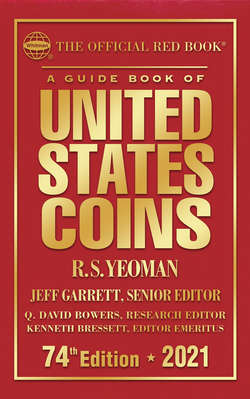Читать книгу A Guide Book of United States Coins 2021 - R.S. Yeoman - Страница 13
На сайте Литреса книга снята с продажи.
MINTS AND MINTMARKS
ОглавлениеMintmarks are small letters designating where coins were made. Coins struck at Philadelphia before 1979 (except 1942–1945 five-cent pieces) do not have mintmarks. Starting in 1979, a letter P was used on the dollar, and thereafter on all other denominations except the cent. Mintmark position is on the reverse of nearly all coins prior to 1965 (the cent is an exception), and on the obverse after 1967.
C—Charlotte, North Carolina (gold coins only; 1838–1861)
CC—Carson City, Nevada (gold and silver coins only; 1870–1893)
D—Dahlonega, Georgia (gold coins only; 1838–1861)
D—Denver, Colorado (1906 to date)
O—New Orleans, Louisiana (gold and silver coins only; 1838–1861; 1879–1909)
P—Philadelphia, Pennsylvania (1793 to date; P not used in early years)
S—San Francisco, California (1854 to date)
W—West Point, New York (1984 to date)
Prior to 1996 all dies for United States coins were made at the Philadelphia Mint. Some dies are now made at the Denver Mint. Dies for use at other mints are made with the appropriate mintmarks before they are shipped to those mints. Because this was a hand operation prior to 1985, the exact positioning and size of the mintmarks may vary slightly, depending on where and how deeply the punches were impressed. This also accounts for double-punched and superimposed mintmarks such as the 1938 D Over D, and D Over S, Buffalo nickels. Polishing of dies may also alter the apparent size of fine details. Occasionally the mintmark is inadvertently left off a die sent to a branch mint, as was the case with some recent Proof cents, nickels, and dimes. Similarly, some 1982 dimes without mintmarks were made as circulation strikes. The mintmark M was used on coins made in Manila for the Philippines from 1925 through 1941.
Prior to 1900, punches for mintmarks varied greatly in size. This is particularly noticeable in the 1850 to 1880 period, in which the letters range from very small to very large. An attempt to standardize sizes started in 1892 with the Barber series, but exceptions are seen in the 1892-O half dollar and 1905-O dime, both of which have normal and “microscopic” mintmarks. A more or less standard-size, small mintmark was used on all minor coins starting in 1909, and on all dimes, quarters, and halves after the Barber series was replaced in 1916. Slight variations in mintmark size occur through 1945, with notable differences in 1928, when small and large S mintmarks were used.
In recent years a single D or S punch has been used to mark all branch-mint dies. The change to the larger D for Denver coins occurred in 1933. Nickels, dimes, quarter dollars, half dollars, and dollars of 1934 exist with either the old, smaller-size mintmark or the new, larger-size D. All other denominations of 1934 and after are standard. The San Francisco mintmark was changed to a larger size during 1941 and, with the exception of the half dollar, all 1941-S coins are known with either small or large mintmarks. Halves were not changed until 1942, and the 1942-S and 1943-S pieces exist both ways. The 1945-S dime with “microscopic” S is an unexplained use of a punch originally intended for Philippine coins of 1907 through 1920. In 1979, the punches were replaced. Varieties of some 1979 coins appear with either the old- or new-shaped S or D. The S punch was again replaced in 1981 with a punch that yielded a more distinct letter.
The mintmark application technique for Proof coins was changed in 1985, and for circulation-strike production in 1990 and 1991, when the letter was applied directly to the master die rather than being hand punched on each working die. At the same time, all the mintmark letters were made much larger and clearer than those of previous years.
